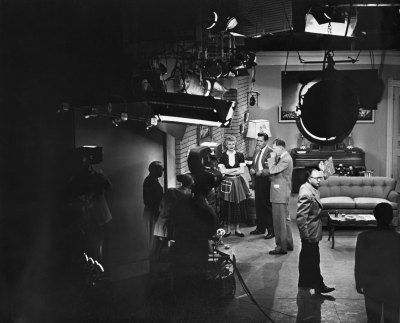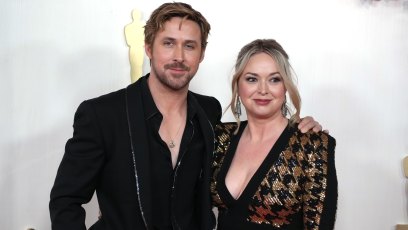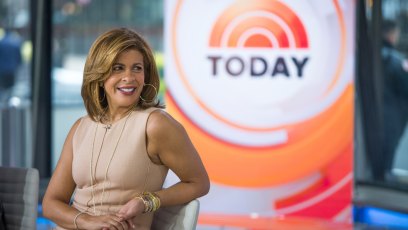We All Love ‘Lucy’, But There’s a Lot You Don’t Know About the Classic TV Show
There are lot of shows out there that can be considered Classic TV, but if we were forced to choose one that impacted not only the audience, but television itself, we would have to point to I Love Lucy. Created by Lucille Ball and Desi Arnaz — who were armed with a trio of amazing writers — they took what could have been a typical sitcom set-up (successful husband who’s an entertainer with a wife who wants to be in show-biz) and turned it into comedic gold.

Much of that gold was mined by Lucy herself, who was wonderful at physical comedy and brilliantly played to the live audience who attended the filming of episodes. How good was she? Let’s put it this way, if you watch certain episodes of the show and she does something funny, you can actually hear Desi’s very distinctive laugh in a scene in which he wasn’t even appearing; he was laughing right along with everyone else — and he knew the jokes.
With all of this in mind, we’ve decided to take a look back at the comic adventures of how Lucy and Ricky Ricardo — as well as their friends Fred and Ethel Mertz (William Frawley and Vivian Vance) — all came together to create some genuine TV magic.
Please scroll down for more
Be sure to check out and subscribe to our Classic TV & Film Podcast for interviews with your favorite stars!
1 of 14

RKO Pictures
Lucy and Desi met on the set of 1940’s Too Many Girls.
The title of the film on which they met could actually be viewed as prophetic given what would eventually happen to their marriage but, in 1940, everything was new and exciting. Desi and Lucy couldn’t keep their eyes — or pretty much anything else — off of each other. On November 30th of that year, they drove to Greenwich, Connecticut, to get married. At the time, Lucy was 29 and Desi was 23. For the record, their wedding was so rushed that Lucy didn’t even get a real wedding ring. Desi picked up a copper one from Woolworth’s five-and-dime. Lucy didn’t mind one bit.
2 of 14

Getty Images
In a way, Lucy owes much of her success to comedian Jack Benny.
As Jess Oppenheimer explained to Lucy biographer Charles Higham, Lucy’s big problem was that she was “hiding” behind the script in the early days of My Favorite Husband. “She didn’t fully trust her instincts as a clown,” he said. “I tried to encourage her to ham it up more, to allow a pause for the laughs I was sure she could get. Finally, I told her I was sending her to school one Sunday. I got her passes to the taping of The Jack Benny Show. Benny was the master of the silent reaction, which he would hold sometimes for twenty seconds on radio. And it worked. Lucy went and saw him, and she told me the next day, ‘I never realized what you can do with just a script and a microphone.’ From then on, she became much more free, much more daring.”
3 of 14

YouTube
The My Favorite Husband radio show.
In some ways, this radio show can be viewed as the “pilot” for the I Love Lucy television series. It ran on the CBS Radio Network from July 23, 1948, to March 31, 1951, and cast Lucy as Liz Cooper and Richard Denning as her husband, George. Although the couple was of a higher social status in the beginning, 10 episodes in writers Bob Carroll Jr., Madelyn Pugh and Jess Oppenheimer took over and they made the Coopers a middle-class couple to help with audience identification. They also came up with story ideas in which Liz’s crazy ideas would trigger outrageous events. It should be noted that that creative trio would eventually move on to I Love Lucy. Additionally, Lucy, who was never acclaimed as an actress, came alive on radio in a way she never did on film, largely because she was able to play to a live audience.
4 of 14

Getty Images
Lucy and Desi needed a project that would keep them together.
Throughout the early years of their marriage, there was a lot of tension between Lucy and Desi — much of it triggered by his extramarital affairs. She lost two babies via miscarriages and, by late 1950, was pregnant with her third. She insisted he be with her during that pregnancy, believing his disappearances during the others led to her emotional pain and the loss. Before this third pregnancy, they had done some stage shows together, with Desi handling music, Lucy taking on the more comedic elements and the two of them playing off of each other brilliantly. It worked big time and led to the decision that they should do a television series together. To do so, they used My Favorite Husband as a model for the type of approach they would take. They disliked the laugh tracks that were used on other shows, and thought that the way things were shot on kinescope rather than film made other shows look pretty awful. They enlisted the aid of Jess, Bob and Madelyn to come up with a concept that incorporated elements from their stage act, plus an older couple for Lucy and Desi to play off of that would eventually become Fred and Ethel Mertz. But the road to get there was not an easy one.
5 of 14

Getty Images
I Love Lucy had to fight its way into existence.
Virtually every idea that Lucy and Desi — who formed their own company called Desilu — came up with was met by resistance from CBS, the network they were pitching their show to. Desi as leading man? No, the audience would never accept him. Shooting on film rather than kinescope? Nope, wouldn’t happen; there was no practical reason to do so. Filming in front of a live studio audience? Nah, there could be hecklers or the crowd could be unruly. Producing the show in California rather than New York? Out of the question.
The couple believed and did what they could, scraping together enough money to cover costs of a pilot (not an easy thing to do) themselves, but they were forced to shoot on kinescope rather than film because the latter was just too expensive. Their agent, Don Sharpe, brought the pilot to New York to get a sponsor, a necessity if they were to get CBS’s interest. In the end, Philip Morris (the cigarette company) saw the potential in the show, if genuine characters could be fleshed out. Desi, Lucy and the writers worked on exactly that. Those characters, of course, were bandleader Ricky Ricardo, his wife Lucy (who was desperate for the limelight herself and would always come up with outrageous schemes to outwit her husband), and their landlords/friends, Fred and Ethel Mertz (William Frawley and Vivian Vance), the four living in an apartment building in New York City.
6 of 14

Getty Images
Then it became the first sitcom to shoot with three cameras in front of a studio audience.
Desi, working with cinematographer Karl Freund, developed the idea of shooting the show with three cameras so that the action could play out more like a stage play than a film, chronologically rather than shooting all sequences in a certain set before moving on to the next one. This process, besides playing so well in front of the studio audience, would give them the opportunity to finesse anything they needed to. The norm now, this was a truly revolutionary approach at the time.
When the pilot was shot and it was brought to CBS, the network was impressed, but insisted that Desi’s name not be in the title. Lucy wouldn’t hear of it. Then someone suggested I Love Lucy, and because Lucy felt that anyone watching the proposed show would know that the “I” meant Desi, so that worked for her. They had a deal.
7 of 14

Getty Images
Speaking of deals….
The show was given a one-season order of 39 episodes (can you imagine that many episodes in one year?) at a budget of $19,500 per installment. Again, CBS wanted the show shot in New York and, again, Lucy and Desi wanted it shot in California and — on film, no less. They agreed to cut their per episode fee from $5,000 to $4,000 in exchange for owning 100 percent of the show. CBS had no problem with that, no one having heard of the concept of reruns before. Eventually, they would sell the rights back to the network for $4.5 million.
8 of 14

Getty Images
Casting Fred and Ethel Mertz.
Desi knew that William Frawley would be perfect as Fred, but the actor had a reputation as a drinker. When confronted with this, William got angry, but Desi said he would go with him on the show. However, there was so much riding on I Love Lucy, that if he did get drunk during production, he’d be fired and blacklisted. Luckily, it never became an issue.
For Ethel, it was actually first season director Marc Daniels who suggested Vivian Vance. She was reluctant, wanting to do movies, but Marc emphasized how great this series was going to be and eventually, after getting a sense of what they had in mind, she signed on. This was a relief as her theater background would give her a sense of ease performing in front of the audience. The downside was that she and William took an instant disliking toward each other, which never really went away.
Insofar as Lucy was concerned, in real life she had given birth to Desi’s daughter, Lucie, and hadn’t met neither William or Vivian. Later, there would be talk of spinning off Fred and Ethel into their own show but, while William was interested, Vivian wasn’t.
9 of 14

Getty Images
Time to enter the Desilu Playhouse.
Finding it difficult to locate a place large enough to house a studio audience and live up to all fire codes, in the middle of the night Desi woke up with the idea of using a movie studio, which had never been done. To do so, the building — General Service Studios Stage 2 — had to be sound-proofed and Desi himself went door to door to get people from the neighborhood to give their written OK for the crowds that would be attending taping. He was successful in doing so, and the Desilu Playhouse came into existence.
10 of 14

Getty Images
Welcome, Little Ricky!
In the second season, Lucy was pregnant with Desi’s second child (Desi Arnaz, Jr.), and that pregnancy was worked into the show. There’s a classic episode where Lucy comes down to Ricky’s club, the Tropicana, to surprise him with the news that they’re having a baby. Absolutely wonderful! The audience would see Little Ricky grow up on the show, with two sets of twins playing the character as infants from 1952-53, a toddler from 1956 to 1957, then he aged two years in the form of actor Richard Keith until 1960.
11 of 14

CBS Television Distribution
There were animated I Love Lucy segments, too.
When the show would go to commercial, it would often feature what was called an "animated bumper" that had cartoon versions of Lucy and Desi, who were promoting Phillip Morris cigarettes. It really wasn't as weird as it sounds today — you may or may not have known this, but The Flintstones originally aired in primetime, and that animated series had Fred, Wilma, Barney and Betty talking about the splendor of Phillip Morris products in commercials. Obviously a very different time.
12 of 14

Getty Images
The Long, Long Trailer brings us Lucy and Desi in color.
Released at the end of 1953, this film cast Desi as Nicholas Collini and Lucy and his bride-to-be, Tracy. Once they’re married, they buy a motorhome rather than a house, embarking on a trip across the country that, needless to say, is pretty tumultuous. The film was a major success — much of it attributed to the audience wanting to see Lucy and Desi in color rather than black and white — and even if the characters aren’t Lucy and Ricky…they kind of are. Many people who discovered the film later was under the impression that it was actually just an extended episode of I Love Lucy.
13 of 14

Getty Images
After The Lucy-Desi Comedy Hour, it was time to move on.
I Love Lucy ran from 1951 to 1957, with Lucy and Desi deciding to end the show on their own despite how well it was doing in the ratings. Then, from 1957 to 1960, the show was retooled to a total 13 one-hour specials over the course of three seasons. Originally titled The Lucille Ball-Desi Arnaz Show, in reruns, it became The Lucy-Desi Comedy Hour. Part of this was to shake up the format and keep it fresh, but much of it had to do with Desi having some health issues, largely from the pace of the past several years taking its toll (none it helped by the incessant drinking he had begun doing in response). Although Lucy and Desi were joined by William and Vivian, the roles of Fred and Ethel were cut down to a minimum and the focus of the show was really on the Ricardos — mostly Lucy — interacting with a variety of celebrities.
The final episode, “Lucy Meets the Mustache” (guest starring Ernie Kovacs) aired on April 1, 1960, and in some ways it truly was an April Fools’ Day joke, because by the time that show went into production, the marriage between Lucille Ball and Desi Arnaz was over. The only reason they even filmed it was to fulfill their contract, but it was painful experience for both of them. Theirs had been a marriage filled with tension many times over the years; Desi accused Lucy of being the proverbial ice queen, Lucy claimed that he cheated on her constantly with younger women. Whatever the truth, it was a crushing end to what had, back in the day, seemed like such a fairy tale romance to the public.
Yet, throughout all of their ups and downs, they managed to create what is one of the purest examples of Classic TV ever. Nearly 70 years later, we still love Lucy — and probably always will.
14 of 14

Getty Images
Let's not forget how the show made the couple award winners.
I Love Lucy won 1953 Emmys for Best Situation Comedy and Best Comedienne (Lucy); 1954 for Best Series Supporting Actress (Vivian Vance) and Best Situation Comedy; and 1956 for Best Actress — Continuing Performance (Lucy).








































